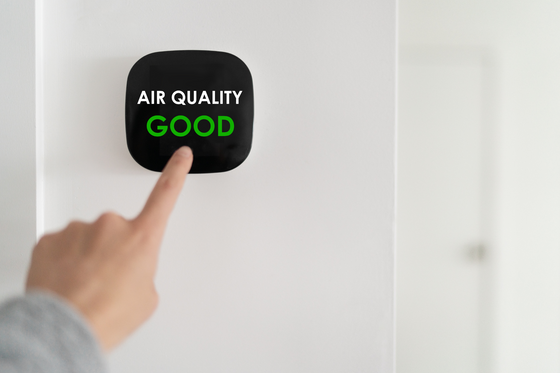
You might not realize it, but the air inside your home could be filled with pollutants, such as formaldehyde and benzene. These toxins can come from household cleaners, paints, and even furniture. Indoor plants can help purify the air and remove these harmful chemicals, making for a healthier living environment. Here are the top 10 best indoor plants for clean air:
The spider plant is a great option for beginners, as it is very easy to care for and can thrive in a variety of lighting conditions. It is also one of the most efficient air purifiers, as it removes a range of toxins, including formaldehyde and carbon monoxide. To care for your spider plant, place it in a well-draining pot with soil and water it when the soil feels dry to the touch. It is a low maintenance plant that can tolerate a bit of neglect, making it a great choice for busy individuals.
English ivy is another popular choice for air purification. It is known for its ability to remove toxins such as benzene, formaldehyde, and carbon monoxide from the air. In addition to its air purifying abilities, English ivy is also a beautiful plant that can add a touch of greenery to any space. It is a climbing plant, so it is best suited for hanging baskets or trained to grow up a trellis or wall. English ivy prefers bright, indirect light and should be watered regularly to keep the soil moist.
Also known as the mother-in-law's tongue, the snake plant is a tough, resilient plant that can tolerate a wide range of lighting conditions. It is an excellent air purifier, as it removes toxins such as formaldehyde and benzene from the air. The snake plant is also low maintenance and can survive for long periods without water, making it a great choice for busy individuals or those who may forget to water their plants. To care for your snake plant, place it in a well-draining pot with soil and water it when the soil feels dry.
The peace lily is a beautiful plant with white, spathy flowers that bloom throughout the year. It is also a great air purifier, as it removes a range of toxins, including benzene, formaldehyde, and trichloroethylene, from the air. In addition to its air purifying abilities, the peace lily is also known for its ability to improve humidity levels, making it a great choice for dry environments. To care for your peace lily, place it in a well-draining pot with soil and water it when the soil feels dry. It prefers bright, indirect light and should be protected from direct sunlight.
The rubber plant is a beautiful, large-leafed plant that can add a tropical touch to any space. It is also an effective air purifier, as it removes toxins such as formaldehyde and benzene from the air. The rubber plant is easy to care for and can tolerate a range of lighting conditions, making it a great choice for beginners. To care for your rubber plant, place it in a well-draining pot with soil and water it when the soil feels dry. It prefers bright, indirect light and should be protected from direct sunlight.
The Boston fern is a beautiful, lacy plant that is known for its ability to purify the air. It removes toxins such as formaldehyde and xylene from the air and is also able to improve humidity levels in dry environments. The Boston fern is a bit more high maintenance than some of the other plants on this list, as it requires consistent watering and prefers bright, indirect light. It is also sensitive to changes in its environment, so it is important to keep it in a stable location and avoid placing it near drafty windows or doors. To care for your Boston fern, place it in a well-draining pot with soil and water it when the soil feels dry. Mist the leaves regularly to provide additional humidity and fertilize it monthly during the growing season.
Dracaena is a popular indoor plant with a variety of species to choose from, including the corn plant, dragon tree, and Janet Craig. These plants are effective air purifiers, as they remove toxins such as formaldehyde, xylene, and toluene from the air. They are also easy to care for, as they can tolerate a range of lighting conditions and only need to be watered when the soil feels dry. To care for your dracaena, place it in a well-draining pot with soil and water it when the soil feels dry. It prefers bright, indirect light and should be protected from direct sunlight.
Aloe vera is a succulent plant that is not only known for its medicinal properties, but also its ability to purify the air. It removes toxins such as formaldehyde and benzene from the air and is also able to improve humidity levels in dry environments. In addition to its air purifying abilities, aloe vera is also easy to care for, as it only needs to be watered when the soil feels dry. To care for your aloe vera, place it in a well-draining pot with soil and water it when the soil feels dry. It prefers bright, indirect light and should be protected from direct sunlight.
The weeping fig, also known as the ficus tree, is a beautiful indoor plant that can add a tropical touch to any space. It is also an effective air purifier, as it removes toxins such as formaldehyde and xylene from the air. The weeping fig is a bit more high maintenance than some of the other plants on this list, as it requires consistent watering and prefers bright, indirect light. To care for your weeping fig, place it in a well-draining pot with soil and water it when the soil feels dry. Protect it from direct sunlight and be careful not to overwater it, as it is susceptible to root rot.
Chrysanthemum is a beautiful flowering plant that is not only known for its vibrant colors, but also its ability to purify the air. It removes toxins such as formaldehyde and benzene from the air and is also able to improve humidity levels in dry environments. Chrysanthemum is a bit more high maintenance than some of the other plants on this list, as it requires consistent watering and prefers bright, indirect light. To care for your chrysanthemum, place it in a well-draining pot with soil and water it when the soil feels dry. Protect it from direct sunlight and fertilize it regularly to encourage healthy growth and flowering.
Common questions about indoor plants for clean air:
Q: How many plants do I need to effectively purify the air in my home?
A: It is recommended to have at least one air purifying plant per 100 square feet of living space. However, more plants will provide even greater benefits and can help create a more vibrant, healthy living environment.
Q: Can these plants be toxic to pets?
A: Some of the plants on this list, such as the peace lily and chrysanthemum, can be toxic to pets if ingested. It is important to research the specific plants you are considering and to keep them out of reach of pets if necessary.
Q: Can these plants be grown outdoors?
A: Most of the plants on this list are best suited for indoor growing, as they prefer stable temperature and lighting conditions and may not be able to withstand extreme weather conditions. However, some of these plants, such as the spider plant and English ivy, can be grown outdoors in the right conditions. It is important to research the specific needs of each plant and to provide adequate light, water, and protection from extreme weather. It is also important to consider any potential dangers to pets or children when deciding to grow these plants outdoors.
Q: Can I grow these plants in a low light environment?
A: Some of the plants on this list, such as the snake plant and pothos, are able to tolerate low light conditions and can still thrive. However, it is important to note that all plants need some amount of light in order to photosynthesize and grow properly. If you are unable to provide bright, indirect light, you may want to consider using a grow light to supplement the light available in your space.
Q: How often should I water these plants?
A: The watering needs of these plants will vary depending on the specific species and the conditions in your home. In general, it is important to check the soil moisture regularly and only water your plants when the soil feels dry to the touch. Overwatering can lead to root rot and other issues, so be sure to allow the soil to dry out slightly between waterings.
Sources:
Comments will be approved before showing up.


